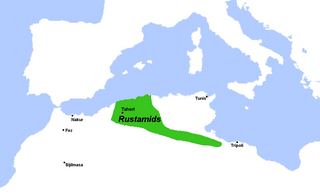
Much of the history of Algeria has taken place on the fertile coastal plain of North Africa, which is often called the Maghreb. North Africa served as a transit region for people moving towards Europe or the Middle East, thus, the region's inhabitants have been influenced by populations from other areas, including the Carthaginians, Romans, and Vandals. The region was conquered by the Muslims in the early 8th century AD, but broke off from the Umayyad Caliphate after the Berber Revolt of 740. During the Ottoman period, Algeria became an important state in the Mediterranean sea which led to many naval conflicts. The last significant events in the country's recent history have been the Algerian War and Algerian Civil War.

Year 765 (DCCLXV) was a common year starting on Tuesday of the Julian calendar. The denomination 765 for this year has been used since the early medieval period, when the Anno Domini calendar era became the prevalent method in Europe for naming years.

Medieval Muslim Algeria was a period of Muslim dominance in Algeria during the Middle Ages, spanning the millennium from the 7th century to the 17th century. The new faith, in its various forms, would penetrate nearly all segments of society, bringing with it armies, learned men, and fervent mystics; in large part, it would replace tribal practices and loyalties with new social norms and political idioms.

Tlemcen is the second-largest city in northwestern Algeria after Oran and is the capital of Tlemcen Province. The city has developed leather, carpet, and textile industries, which it exports through the port of Rachgoun. It had a population of 140,158, as of the 2008 census.

The Rustamid dynasty was an Ibadi Persian dynasty centered in present-day Algeria. The dynasty governed as a Muslim theocracy for a century and a half from its capital Tahert until the Ismaili Fatimid Caliphate defeated it. Rustamid authority extended over what is now central and western Algeria, parts of southern Tunisia, and the Jebel Nafusa and Fezzan regions in Libya as far as Zawila.
Idris (I) ibn Abd Allah, also known as Idris the Elder, was a Hasanid and the founder of the Idrisid dynasty in part of northern Morocco, after fleeing the Hejaz as a result of the Battle of Fakhkh. He ruled from 788 to 791. He is credited with founding the dynasty that established Moroccan statehood and is regarded as the "founder of Morocco".
The Zenata are a group of Berber tribes, historically one of the largest Berber confederations along with the Sanhaja and Masmuda. Their lifestyle was either nomadic or semi-nomadic.
The Maghrawa or Meghrawa were a large Zenata Berber tribal confederation whose cradle and seat of power was the territory located on the Chlef in the north-western part of today's Algeria, bounded by the Ouarsenis to the south, the Mediterranean Sea to the north and Tlemcen to the west. They ruled these areas on behalf of the Umayyad Caliphate of Cordoba at the end of the 10th century and during the first half of the 11th century.

The Idrisid dynasty or Idrisids were an Arab Muslim dynasty from 788 to 974, ruling most of present-day Morocco and parts of present-day western Algeria. Named after the founder, Idris I, the Idrisids were an Alid dynasty descended from Muhammad through his grandson Hasan. The Idrisids are traditionally considered to be the founders of the first Moroccan state, setting the stage for subsequent dynasties and states centered in this region. Their reign played an important role in the early Islamization of Morocco and also presided over an increase in Arab immigration and Arabization in major urban centers.
The Berber Revolt or the Kharijite Revolt of 740–743 AD took place during the reign of the Umayyad Caliph Hisham ibn Abd al-Malik and marked the first successful secession from the Arab caliphate. Fired up by Kharijite puritan preachers, the Berber revolt against their Umayyad Arab rulers began in Tangiers in 740, and was led initially by Maysara al-Matghari. The revolt soon spread through the rest of the Maghreb and across the straits to al-Andalus.
The Berbers are an indigenous ethnic group of the Maghreb region of North Africa. Following the Muslim conquest of the Maghreb, most Berber tribes eventually became Muslims. Presently, about one-sixth of the population of Maghreb speaks one of the Berber languages, but most of them also speak some form of Arabic. Berbers are the first non-Arab people to have established an Islamic state.
The Banu Ifran or Ifranids, were a Zenata Berber tribe prominent in the history of pre-Islamic and early Islamic North Africa. In the 8th century, they established a kingdom in the central Maghreb, with Tlemcen as its capital.
For the Melkite theologian, see Theodore Abu Qurrah
The Midrarid dynasty was a Berber dynasty that ruled the Sijilmasa region in Morocco from their capital of Sijilmasa, starting in the late 8th or early 9th century to 976/7.

The Sulaymanid dynasty was an Arab Muslim dynasty in present-day western Algeria, ruling from 814 to 922. The dynasty is named after the founder, Sulyaman I, who was the brother of Idris I, the founder of the Idrisid dynasty based in Fez. Both Sulayman and Idris, as great grandchildren of Hasan ibn Ali, were sharifs descended from Muhammad.
The Zirids conquered the western Maghreb in 979 when Buluggin Ibn Ziri led a campaign to expand his territory. He captured most of present-day Morocco by 980, which remained briefly under Zirid control until his death in 984.

The Abbasid conquest of Ifriqiya was an armed campaign in 761 against Kharijite Ibadites in Ifriqiya led by Muhammad ibn al-Ash'ath al-Khuza'i on behalf of the Abbasid Caliphate. By the end of the campaign, the Abbasids brought the political domination of the Ibadites in Ifriqiya to an end, and recovered Abbasid authority in the Maghreb as far as eastern Algeria.

The Malikization of the Maghreb was the process of encouraging the adoption of the Maliki school of Sunni Islam in the Maghreb, especially in the 11th and 12th centuries, to the detriment of Shia and Kharijite inhabitants of the Maghreb. The process occurred as Maliki scholars increasingly gained influence, resulting in the widespread acceptance of the Maliki legal school and the subsequent marginalization of other forms of Islam. Malikism was considered a more conservative and mainstream variant of Sunni Islam.
The Talkata or Telkata constitute a branch of the sedentary faction of the Sanhaja in central Maghreb, with their stronghold being Titteri, during the Middle Ages. They played a prominent role in the history of the Muslim Maghreb and are the progenitors of the Zirid dynasties that ruled over central Maghreb, Ifriqiya, and Al-Andalus. The Telkata tribe went extinct during the French Invasion of Algeria.

The Zayyanid-Almohad wars (1236–1248), also known as the Tlemcen-Almohad wars, were a series of conflicts that occurred between the Zayyanid dynasty, rulers of the Kingdom of Tlemcen in present-day Algeria, and the Almohad Caliphate, a North African Berber-Muslim empire that existed from the 12th to the 13th centuries. These wars took place during the Almohad period and were primarily fought over territorial control and influence in the Maghreb region of North Africa.










